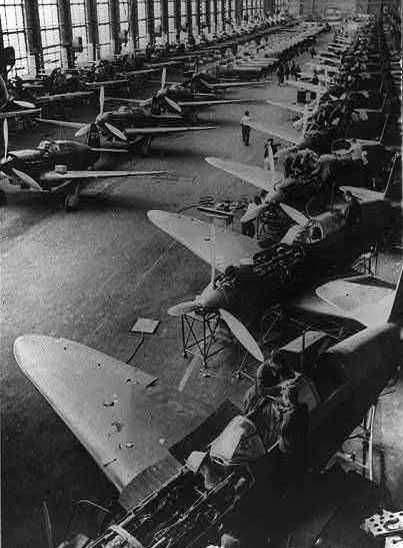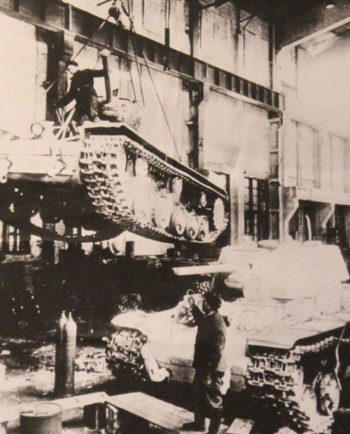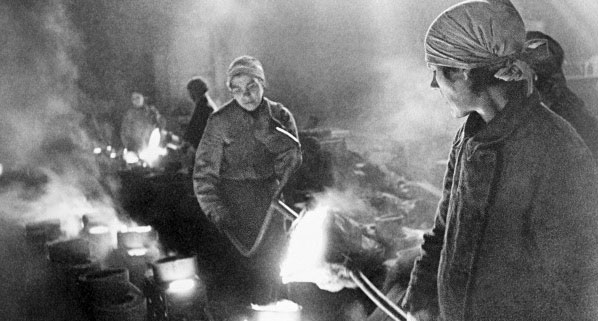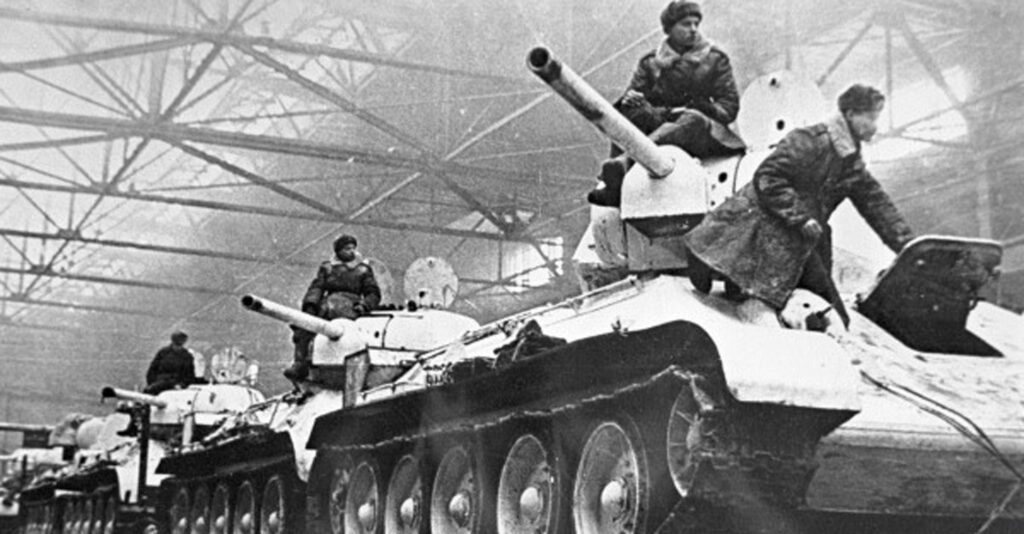The first months of Operation Barbarossa, i.e. the Third Reich’s invasion of the USSR, were a devastating defeat for the Russians. The Red Army retreated in panic, but in the chaos of war the need to evacuate factories to the east was not forgotten, in order to continue the production of everything the USSR armed forces needed to win the Second World War. Despite the lack of equipment, people and food, it is estimated that by the end of 1941 more than 1,500 factories with millions of workers and engineers had been relocated.
The German invasion was a powerful blow to the economy of the Soviet Union, whose GDP fell by 34% between 1940 and 1942. Industrial production for almost a decade did not return to its 1940 level. Despite the fact that Germany occupied only 3% of the USSR’s area, almost half of Stalin’s armaments factories were located on this piece of land.
As early as June 30, 1941, the Soviets established the State Defense Committee, i.e. the organization managing and coordinating the transport of industrial centres to the east, far from the approaching rapid pace of the Germans. The Committee, which had virtually unlimited authority to evacuate people and equipment, used everything that could have helped in any way – mainly the Soviet railway fleet. Even outdated locomotives and wagons in poor technical condition were used in acts of desperation.

picryl.com
The evacuation focused on factories located in the territory of present-day Ukraine and the Moscow area, i.e. industrialised areas, the loss of which the Red Army feared the most. In each of them an evacuation council was created, which consisted of the directors of the factories, engineers and, of course, political officers. Movements of each of the factories began with the export of items that did not affect the current production, such as overstock. The specialists divided all machines and other equipment into categories, which were to indicate how important the equipment was and how difficult it was to dismantle and reassemble. Interestingly, in the relocated factories, production was to remain intact until the very moment of evacuation, which often took place dangerously close to the arrival of the front.
As you probably guess, despite planning, during the nervous relocation of factories, chaos, lack of coordination and human error often occurred. Managers and workers had to improvise. Most often there was a lack of equipment capable of loading machines (such as rolling mills or forging dies), which weighed several dozen tons each. In such cases, such colossuses were painstakingly dismantled into parts, and it often turned out that some of them had been welded earlier. Trains transporting equipment from factories were overloaded and overcrowded. Nobody worried about something like the maximum load on the train depot – after all, the motherland needed this equipment several hundred kilometers away from the Nazis running eastwards. Here, however, the problem often arose because the Soviet rails were made of poor quality steel and were damaged by the heavy trains moving on them.
When the machines couldn’t be carried, it was only possible to destroy them so that they wouldn’t fall into the hands of the Germans – but it was rare, because it was extremely difficult to get explosives.
It is worth mentioning here the contribution of Soviet railwaymen, who took the subject of evacuation extremely seriously. Not only did the trains take people and equipment away from the frontline, but also transported millions of soldiers to the battlefields. From Moscow alone, 80,000 wagons transported machines and parts from almost 500 factories.

Deror_avi via Wikimedia Commons
Throughout the evacuation period there were serious shortages of food, people and equipment. However, the worst were the problems that affected the railway vehicles, i.e. the high failure rate of wagons and locomotives, their low accessibility and the ” jamming” of the railway routes. Every day thousands of wagons were disposed of at stations for many hours, which caused delays in the evacuation of the USSR industry. It happened that one train stood at the station even for a few weeks! In addition, the maps used by railwaymen were often full of errors. Soviet cartographers were ordered to purposefully falsify the maps if they were to get into the hands of the Germans.
In addition to machines and equipment, trains also deported people – mainly factory workers and their families. Their travel conditions were often really tragic, as the wagons were often unheated and lacked space to sleep, which most often resulted in sleeping between machines on blankets, clothes or sawdust. Travellers in this way also suffered from a lack of food, water, and colds caused by severe frosts.
If the transport from the factory had already managed to reach its destination, it did not mean the end of the difficulties, because the equipment had to be unloaded and returned. Often there was a lack of documentation, parts were lost or stolen along the way, and all this was accompanied by terrible working conditions. The workers worked up to 14 hours a day, and because of the lack of hands, women and children were not spared either. The communist authorities of the USSR also reached for Gulag prisoners. Heavy, physical work combined with malnutrition, frost and lack of accommodation meant that many people did not survive.
Despite all these difficulties, as well as the organizational chaos and warfare that spread across more and more of the USSR territory, it is estimated that by the end of 1941 more than 1500 large factories were deported, together with millions of workers, engineers and their family members. Nearly 500 factories were moved to the Urals, more than 200 to Western Siberia and 250 to Central Asia. The others were evacuated further east, even off the Pacific coast. Locations rich in raw materials and far from the front were chosen so that they would not be exposed to Luftwaffe air raids.

Vsevolod Tarasevich via Wikimedia Commons
During the rescue of the factories, priority was given to the military plants and they were the fastest to transport and restart – there were individual cases even a month after the start of the relocation. The first T-34 tank assembled in the relocated factory (Nizhny Tagila in the Urals) left the production line already in December 1941, and most of the military production started in the first half of 1942, just before the Stalingrad Battle, which began in August 1942 and was the turning point of the Second World War for the Soviet Union. It is worth mentioning that the hasty launch of production had an impact on the poor quality and higher failure rate of the manufactured weapons – an example of this can be the already mentioned medium T-34 tank, which, depending on the place of manufacture, could even have slightly different dimensions from the same type of tank produced in another factory.
But not everything came out as it should. Nearly 300 factories did not reach their destination at all – they simply got lost in transport, were stolen or taken over by the Germans. Some of the plants were too difficult to relocate (such as smelters) and sometimes even attempts were not made to export, but were destroyed on the spot. It happened that the Germans approached the factory too quickly and its crew, in order to avoid the Wehrmacht seizing the equipment, sent it east by the first better train. The cargo left on its own could circulate around the country even for months and if it wasn’t stolen by some miracle, there were a few cases of unloading such machines and starting production in a completely different place, with the help of other people than originally assumed!
In the long term, the USSR industry benefited from the evacuation action despite the great chaos that accompanied the whole operation. Powerful industrial centres were created and many factories were built or expanded, such as the factory in Chelyabinsk, where tanks were produced. This factory was so large that the whole city was called “Tank City”. In addition, a more efficient system of work was developed in many factories by tightening ever lower time limits for the production of equipment.

